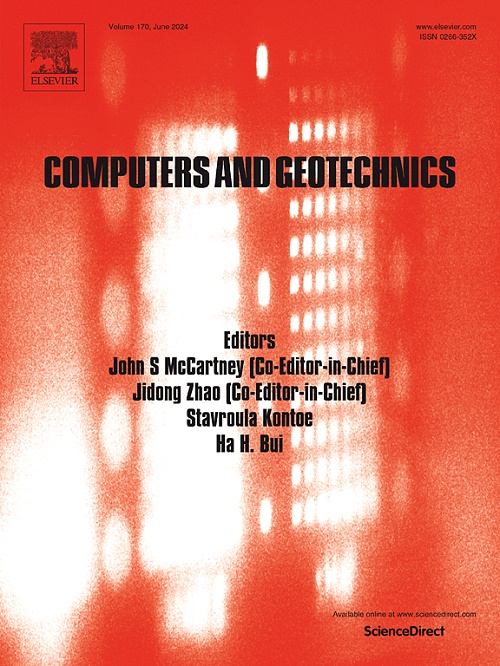岩土大变形分析的颗粒-细胞混合(PCH)新方法
IF 5.3
1区 工程技术
Q1 COMPUTER SCIENCE, INTERDISCIPLINARY APPLICATIONS
引用次数: 0
摘要
粒子有限元法(PFEM)及其变体,如光滑粒子有限元法(SPFEM),在岩土工程问题分析中得到了广泛的应用。然而,质量守恒的挑战往往会影响各种应用中数值结果的准确性。在这项研究中,我们引入了一种新的策略,通过将材料点的概念整合到SPFEM中来解决这个问题,从而建立了粒子-细胞混合(PCH)方法。这种方法在保证质量守恒的同时保留了SPFEM的优点。其核心思想包括在计算过程中整合每个粒子的质量信息。尽管它很简单,但通过一系列基准测试,这种治疗方法已被证明是稳健和有效的。此外,数值实验表明,PCH方法大大降低了PFEM框架下边界识别技术对非物理因素的敏感性。所提出的框架是PFEM发展的一个重大进步,并且可以很容易地与其他PFEM代码和软件相结合,以提高它们的数值精度。本文章由计算机程序翻译,如有差异,请以英文原文为准。
A novel particle-cell hybrid (PCH) method for geotechnical large deformation analysis
The Particle Finite Element Method (PFEM) and its variants, such as the Smoothed PFEM (SPFEM), have gained popularity for analysing geotechnical problems. However, the challenge of mass conservation often compromises the accuracy of numerical results across various applications. In this study, we introduce a novel strategy to address this issue by integrating the concept of material points into SPFEM, thereby establishing a Particle-Cell Hybrid (PCH) method. This approach retains the advantages of SPFEM while ensuring mass conservation. The core idea involves incorporating mass information for each particle during computations. Despite its simplicity, this treatment has proven to be robust and effective through a series of benchmarking tests. Additionally, numerical experiments demonstrate that the PCH method considerably reduces sensitivity to unphysical factors in the boundary identification technique employed within the PFEM framework. The proposed framework represents a significant advancement in the development of PFEM, and can be easily incorporated into other PFEM codes and software to improve their numerical accuracy.
求助全文
通过发布文献求助,成功后即可免费获取论文全文。
去求助
来源期刊

Computers and Geotechnics
地学-地球科学综合
CiteScore
9.10
自引率
15.10%
发文量
438
审稿时长
45 days
期刊介绍:
The use of computers is firmly established in geotechnical engineering and continues to grow rapidly in both engineering practice and academe. The development of advanced numerical techniques and constitutive modeling, in conjunction with rapid developments in computer hardware, enables problems to be tackled that were unthinkable even a few years ago. Computers and Geotechnics provides an up-to-date reference for engineers and researchers engaged in computer aided analysis and research in geotechnical engineering. The journal is intended for an expeditious dissemination of advanced computer applications across a broad range of geotechnical topics. Contributions on advances in numerical algorithms, computer implementation of new constitutive models and probabilistic methods are especially encouraged.
 求助内容:
求助内容: 应助结果提醒方式:
应助结果提醒方式:


